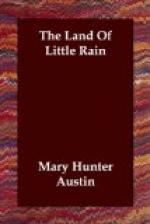by ploughed ground; but from the mouth of Tinpah Creek,
where the deer come out of the Sierras, it is easily
seen that the creek, the point of Black Rock, and
Charley’s Butte are in line with the wide bulk
of shade that is the foot of Waban Pass. And along
with this the deer have learned that Charley’s
Butte is almost the only possible ford, and all the
shortest crossing of the valley. It seems that
the wild creatures have learned all that is important
to their way of life except the changes of the moon.
I have seen some prowling fox or coyote, surprised
by its sudden rising from behind the mountain wall,
slink in its increasing glow, watch it furtively from
the cover of near-by brush, unprepared and half uncertain
of its identity until it rode clear of the peaks,
and finally make off with all the air of one caught
napping by an ancient joke. The moon in its wanderings
must be a sort of exasperation to cunning beasts,
likely to spoil by untimely risings some fore-planned
mischief. But to take the trail again; the coyotes
that are astir in the Ceriso of late afternoons, harrying
the rabbits from their shallow forms, and the hawks
that sweep and swing above them, are not there from
any mechanical promptings of instinct, but because
they know of old experience that the small fry are
about to take to seed gathering and the water trails.
The rabbits begin it, taking the trail with long,
light leaps, one eye and ear cocked to the hills from
whence a coyote might descend upon them at any moment.
Rabbits are a foolish people. They do not fight
except with their own kind, nor use their paws except
for feet, and appear to have no reason for existence
but to furnish meals for meat-eaters. In flight
they seem to rebound from the earth of their own elasticity,
but keep a sober pace going to the spring. It
is the young watercress that tempts them and the pleasures
of society, for they seldom drink. Even in localities
where there are flowing streams they seem to prefer
the moisture that collects on herbage, and after rains
may be seen rising on their haunches to drink delicately
the clear drops caught in the tops of the young sage.
But drink they must, as I have often seen them mornings
and evenings at the rill that goes by my door.
Wait long enough at the Lone Tree Spring and sooner
or later they will all come in. But here their
matings are accomplished, and though they are fearful
of so little as a cloud shadow or blown leaf, they
contrive to have some playful hours. At the spring
the bobcat drops down upon them from the black rock,
and the red fox picks them up returning in the dark.
By day the hawk and eagle overshadow them, and the
coyote has all times and seasons for his own.




